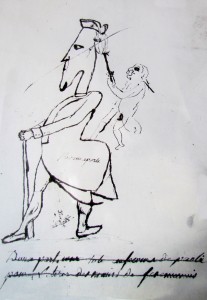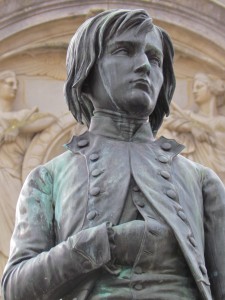 I’ve been thinking back about my visit to Brienne, the French country town where Napoleon attended his first military school from age nine to fifteen. By all accounts he grew up isolated, mocked for his accent and poverty. Even his politics brought derision as this drawing—the earliest known Napoleonic caricature—shows. In it, a fellow student depicts proud Napoleon saving his childhood hero, the Coriscan revolutionary Pasquale Paoli. How many potential heroes (or musicians, artists, scientists, writers) give up their dreams in the face of schoolhouse mockery?
I’ve been thinking back about my visit to Brienne, the French country town where Napoleon attended his first military school from age nine to fifteen. By all accounts he grew up isolated, mocked for his accent and poverty. Even his politics brought derision as this drawing—the earliest known Napoleonic caricature—shows. In it, a fellow student depicts proud Napoleon saving his childhood hero, the Coriscan revolutionary Pasquale Paoli. How many potential heroes (or musicians, artists, scientists, writers) give up their dreams in the face of schoolhouse mockery?
Not Napoleon. Near the end of his Brienne school days, Napoleon’s pride turned into leadership, best demonstrated by his organization of fellow schoolmates in a legendary snowball fight featuring snow forts and snow artillery bombardments. Several years later, his hero Paoli described young Napoleon as a figure out of Plutarch’s Lives.
 After his graduation in 1784, Napoleon returned to Brienne twice: first in 1805, at the height of his powers on his way to Italy to be crowned king, and then again in 1814, during desperate battles to save his empire before his first abdication. Looking back, Napoleon said, “Brienne is my homeland. It’s there I formed the first impressions of my fellow man.” It was in Brienne that he learned, as he later wrote, “to be alone in the midst of men.” It was there he became a leader, and it was there he felt the crumbling of the empire he had built. Few of us experience such symmetry in our lives.
After his graduation in 1784, Napoleon returned to Brienne twice: first in 1805, at the height of his powers on his way to Italy to be crowned king, and then again in 1814, during desperate battles to save his empire before his first abdication. Looking back, Napoleon said, “Brienne is my homeland. It’s there I formed the first impressions of my fellow man.” It was in Brienne that he learned, as he later wrote, “to be alone in the midst of men.” It was there he became a leader, and it was there he felt the crumbling of the empire he had built. Few of us experience such symmetry in our lives.
